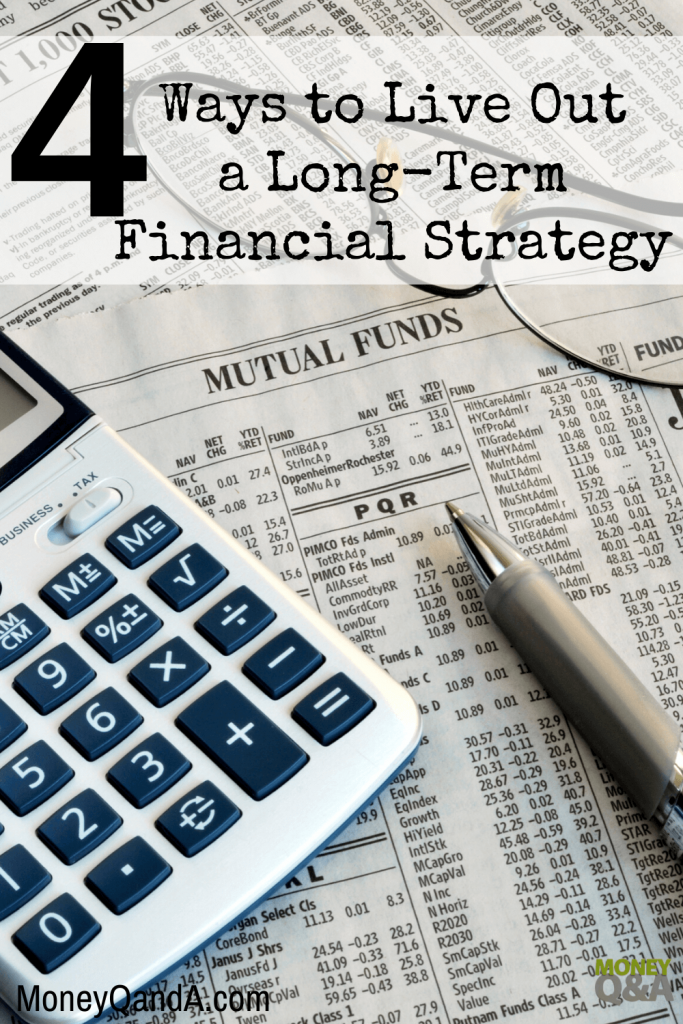
Have you heard the expression, “You spend money as if it’s burning a hole in your pocket?” If so, that probably means there’s room for improvement when thinking about long term financial strategy and plans.
If you’re able to make enough money to put food on the table and keep a roof over your head, you should still think seriously about things you can do now so you’ll have more money in the future.
4 Ways to Live Out a Long Term Financial Strategy
Set Realistic Money-Saving Goals

When people mull over money and the future, their minds often go straight to retirement. Actually though, the future is any time beyond the current moment, so when you consider saving money for future use, it doesn’t have to exclusively relate to retirement.
Let’s say you set a goal of saving $20 from each of your weekly paychecks. You can put that amount into an interest savings account so the balance naturally grows, albeit very slowly, over time. Or, you may decide to buy one less latte from the local coffee shop each week and put the money saved into a jar that goes towards a special major purchase.
Whatever the case may be, don’t set yourself up for failure by making goals you can’t feasibly reach. By doing so, you may feel constantly discouraged, and give up before making any real progress with your savings plan.
Improve Your Financial Literacy
The amount of knowledge you have about finances is also known as financial literacy. Are you feeling confused about debt reduction strategies or wondering how to set up a 401k plan? If so, you’ll likely benefit by becoming more financially aware.
An easy way to start is to subscribe to The Wall Street Journal, Financial Times, or some other finance focused publication. You can also check your local bank to see if classes are offered for consumers who want to learn more about personal finance.
Remember, it’s never too late to become more financially literate. By expressing a mere interest in doing so, you’re taking an important first step toward financial confidence.
Curb Needless Spending
Many people have trouble saying “no” when there is an opportunity to buy “things”. From packs of chewing gum at the checkout to clothing bought despite having a closet full of like-new attire, impulse purchases can really make it difficult to keep your eyes on the future of your finances and your long-term financial strategy.
The easiest way to avoid spending money impulsively is to understand your triggers and do what you can to stay out of situations that activate them. Begin by making a note on a piece of scrap paper every time you feel the need to spend money on an item that’s not truly necessary. At the end of the day, week, or another span of time, take a look at what you wrote down and see when you most often felt tempted to spend money.
For some people, their weakness is going to the shopping mall, while others love online shops and buying things from the comfort of home. Whatever the specifics are in your case, take action to limit your exposure to those triggers. As a result, your impulse spending should go down, and the amount in your bank account will gradually increase.
Download Helpful Financial Apps
App-enabled smartphones and tablets put financial information at our fingertips, and if you own a gadget that can download applications, consider downloading at least a few related to your finances. There are titles that help you plan and stick to budgets, reduce your debt, and most importantly for the context of this article, make it easier to invest money for the future.
Generate Passive Income Streams
Unless you’re saving 40-50% of your income throughout your working life and don’t want relatively hands-off income opportunities during your retirement years, you’ll likely need a passive income stream to support your early retirement goals. Although retiring from your day job is the end goal, you shouldn’t abandon money-making ventures altogether. Instead, generating a passive income with automated investing or dividend reinvestment plans is ideal for anyone who wants to retire in their 50s.
Roofstock
Roofstock is the #1 marketplace for buying and selling single-family rental homes. Roofstock has listings in over 40 markets across the US. 1 in 10 homes in the U.S. is single-family rentals (SFR), which equates to over 15 million households.
Roofstock’s marketplace offers rental homes for sale in 40 markets and 21 states nationwide, and they are continuing to expand. Roofstock surpassed $1 billion of collective transaction volume within two years of its marketplace launch, making it one of the fastest-growing FinTech startups of all time.
PeerStreet
PeerStreet is another great marketplace for investing in real estate backed loans. PeerStreet’s platform provides investments in high-yield, short-term loans focused 100% on real estate debt. PeerStreet is backed by American venture capital firm Andreessen-Horowitz.
Building a real estate portfolio with PeerStreet is simple. You can create your own portfolio of real estate loan investments, or you can allow PeerStreet to do the research and investing for you with automated investing capability. You just select a few custom parameters, and PeerStreet will place you into real estate loans automatically.
Streitwise
Streitwise is a Reg A real estate crowdfunding platform for both accredited and non-accredited investors. Streitwise is currently promoting a public REIT Offering that buys office properties in the Midwest. So far they’ve raised over $28 million from our partners and investors with 10% annual dividend returns since 2017.
Streitwise directly owns and operates its own commercial properties, whereas many other web-based investment platforms serve as middlemen between everyday investors and real estate property managers. This hands-on approach to asset management is nearly unparalleled in the real estate segment of the fintech industry, which arguably could lead to better performance for these assets over time.
They’ve had a strong performance through the recent recession. As of July 2021, they have collected 100% of contractual rent obligations from every tenant in the portfolio. Overall, their strong credit tenants have done well through the recession, and they’re confident going forward. They were also one of the only investing platforms not to pause redemptions through the recession.
Anyone who has at least $5,000 available to invest and a desire to diversify their portfolio beyond stocks and bonds should consider investing in commercial real estate with Streitwise. The low fees, the potential for high returns, proven historical performance, and passive income earning potential are ideal for everyday investors who were previously shut out of commercial investments due to the enormous entry barriers and complexity of this particular market.
People often say they have a long-term financial strategy, but there’s a big difference between making statements and actually living a lifestyle that you can achieve within realistic timeframes. Dedication and planning are required for success, but if you’re serious about focusing on long-term financial goals, that commitment could really pay off.

